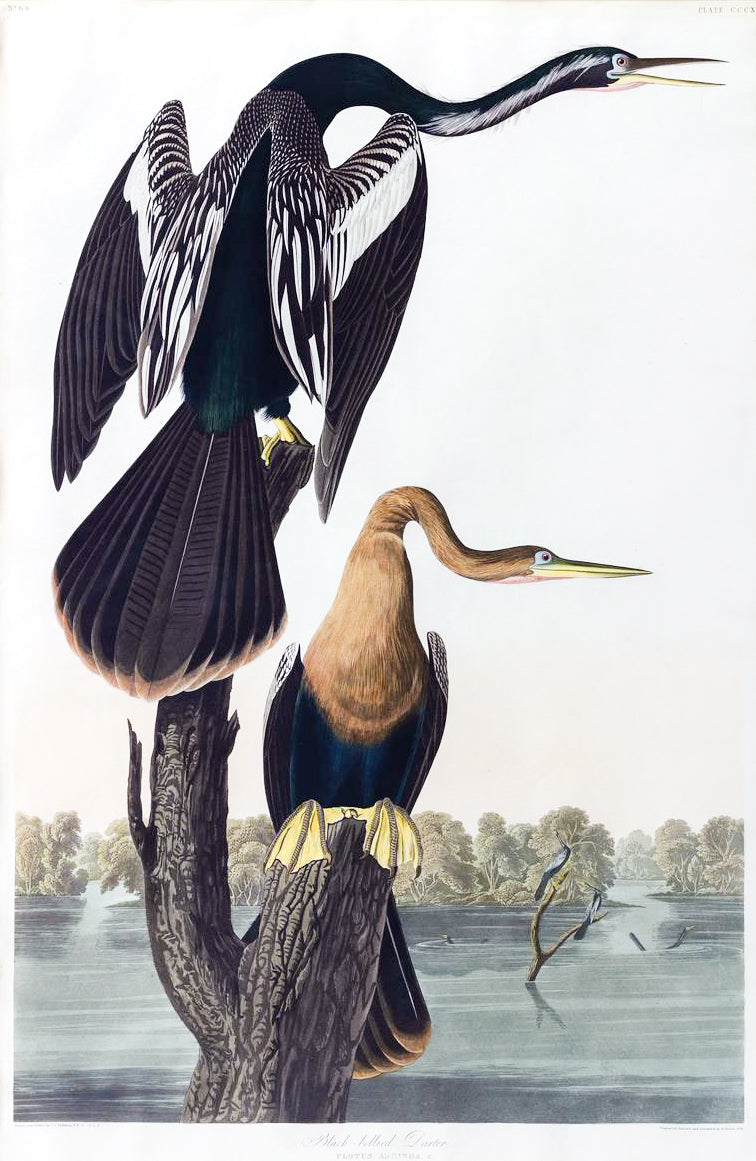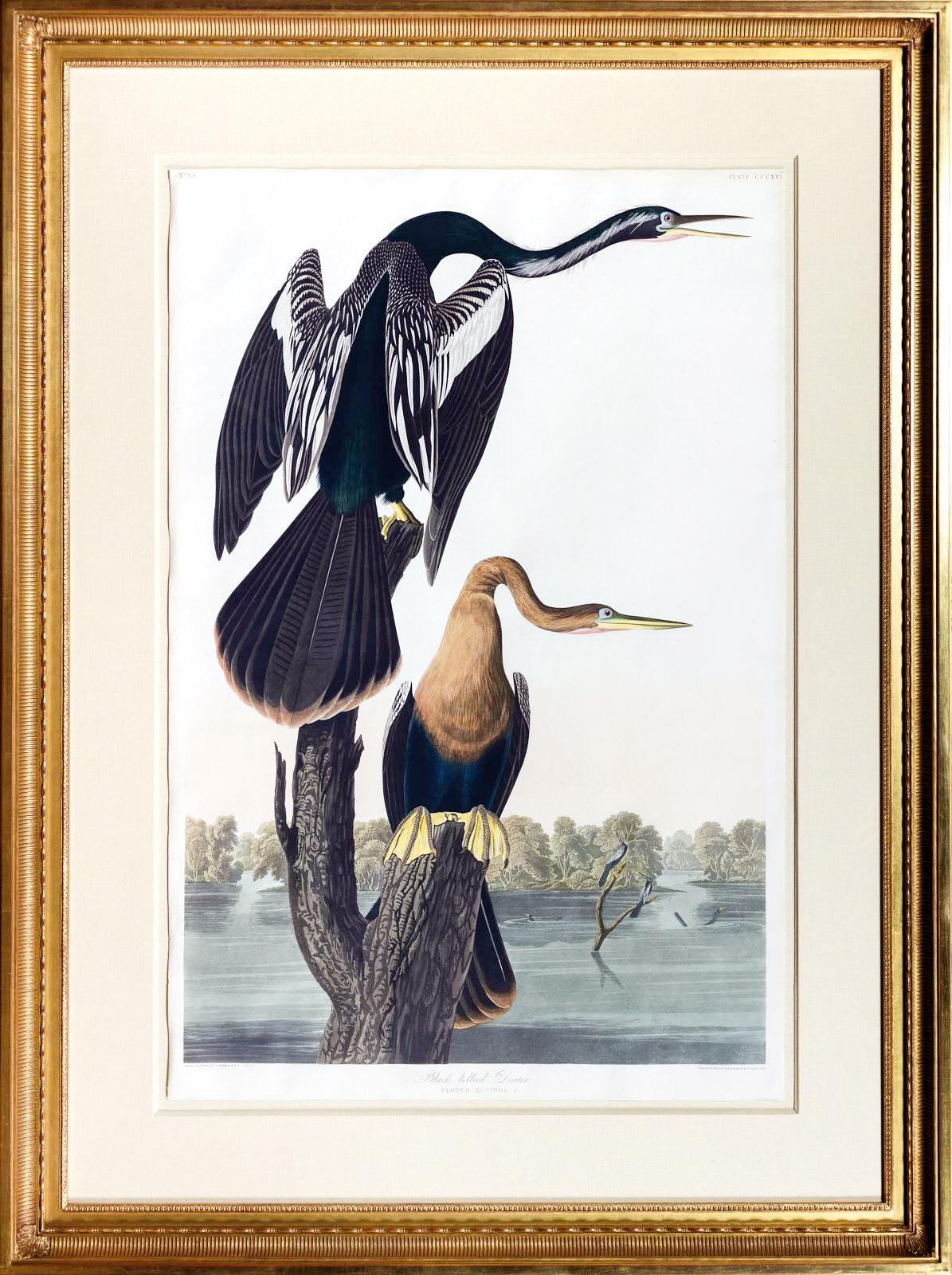John James Audubon (1785-1851), Black-Bellied Darter [Anhinga], Plate 316.
John James Audubon (1785-1851), Black-Bellied Darter [Anhinga], Plate 316.
Couldn't load pickup availability
AUDUBON, John James (1785 - 1851).
Black-Bellied Darter [Anhinga], Plate 316.
Aquatint engraving with original hand color.
London: Robert Havell, 1827-1838.
38" x 24 3/4" sheet, 50" x 37" framed.
Comparable: Arader, 2014 - $42,700; Christie's, 2004 - $38,246.
"This was my father's favorite Audubon in his Radnor, Pennsylvania home." - Graham Arader.
"I may here at once tell you that all the roosting places of the Anhinga which I have seen were over water... and this situation they seem to select because there they can enjoy the first gladdening rays of the morning sun or bask in the blaze of its noontide splendour... [They] stand erect, with their wings and tail fully or partially spread out in the sunshine, whilst their long slender necks and heads are thrown as it were in every direction by the most curious and sudden jerks and bendings." (Audubon, Birds of America [1870-71], vol.VII,pp.156-157). "Just prior to breeding, Anhingas engage in the act of 'peering around,' in which the birds, sitting upright, partially extend their heads and necks and then look slowly and repeatedly to the left and right. The S-shaped curve clearly visible in this species's neck exists because of a modification in the Anhinga's eighth and ninth vertebrae, which, together with the specialized musculature, allows the bird to dart its neck out quickly, while swimming underwater with its large, fully webbed feet, and spear a fish. ... Anhingas' feathers are not waterproof, and the birds must dry them out frequently to keep them from becoming water-logged. Thus they choose feeding areas near trees with open branches where they can conveniently perch and roost, spreading their wings to allow the water to disperse" (C.A. Slatkin in John James Audubon, The Watercolors for the Birds of America New York: 1993, p.124). One of Audubon's most imposing compositions from his monumental Birds of America, published in 4 volumes between 1827 and 1838.
John James Audubon is without rival as the most celebrated American natural history artist. Audubon devoted his life to realizing his dream of identifying and depicting the birds of North America, and his work has had profound cultural and historical significance. In the second decade of the 19th century, he set out to travel throughout the wilderness of the United States, drawing every notable species of native bird. His remarkable ambition and artistic talent culminated in the publication of the monumental Birds of America in 1827-38, a series of 435 aquatints that have only grown in fame since the time of their first appearance. This work established Audubon as an early American artist who could attract European attention, and for many, he personified New World culture and its emerging independent existence.
Audubon was born in Haiti, the illegitimate Creole son of a French sea merchant and a local chambermaid. He was raised in France until 1803, when his father sent him to the United States to avoid being drafted into the Napoleonic wars. There he started what proved to be a long run of unsuccessful schemes. He tried to run a lead mine in Pennsylvania. It folded. After marrying, he opened up a store in Louisville and it, too, went under. He started a steamboat line, and it led him into bankruptcy. By then he was 35 and, he admitted to his wife, a failure.
But throughout his life he nourished a passion for the study and illustration of bird life. At the time, marketing was not as unlikely an endeavor for Audubon as it might seem today. It was a respectable, if somewhat chancy, business, and natural history was a popular subject; in fact, Audubon faced considerable competition. He had little formal training in art and even less in ornithology, but what he lacked in experience he made up for in braggadocio. He pursued his birds with an unusual passion for accuracy and painterly beauty, a fervor caused as much by desperation as by scientific and aesthetic high-mindedness. For years he tracked his subjects to the known edges of the country; the journals he kept along the way are a literary achievement in themselves. By his death in 1851, he had completed 584 individual studies, 435 of which appeared in The Birds of America.
![John James Audubon (1785-1851), Black-Bellied Darter [Anhinga], Plate 316.](http://aradernyc.com/cdn/shop/files/Audubon_Anhinga-2.jpg?v=1684253594&width=1445)
![John James Audubon (1785-1851), Black-Bellied Darter [Anhinga], Plate 316.](http://aradernyc.com/cdn/shop/files/Audubon_Anhinga.jpg?v=1684253600&width=1445)


